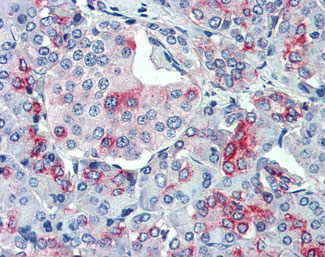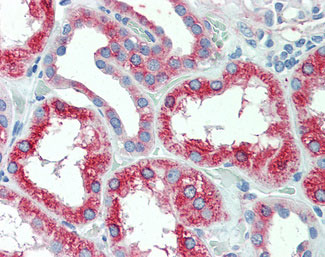SLC11A2 / DMT1 Antibody (Internal)
Rabbit Polyclonal Antibody
- SPECIFICATION
- CITATIONS
- PROTOCOLS
- BACKGROUND

Application
| IHC-P |
|---|---|
| Primary Accession | P49281 |
| Reactivity | Human, Monkey |
| Host | Rabbit |
| Clonality | Polyclonal |
| Calculated MW | 62kDa |
| Dilution | IHC-P (15-20 µg/ml) |
| Gene ID | 4891 |
|---|---|
| Other Names | Natural resistance-associated macrophage protein 2, NRAMP 2, Divalent cation transporter 1, Divalent metal transporter 1, DMT-1, Solute carrier family 11 member 2, SLC11A2, DCT1, DMT1, NRAMP2 |
| Target/Specificity | Human SLC11A2. BLAST analysis of the peptide immunogen showed no homology with other human proteins. |
| Reconstitution & Storage | Long term: -70°C; Short term: +4°C |
| Precautions | SLC11A2 / DMT1 Antibody (Internal) is for research use only and not for use in diagnostic or therapeutic procedures. |
| Name | SLC11A2 |
|---|---|
| Synonyms | DCT1, DMT1, NRAMP2 |
| Function | Proton-coupled metal ion symporter operating with a proton to metal ion stoichiometry of 1:1 (PubMed:17109629, PubMed:22736759, PubMed:25491917, PubMed:17293870, PubMed:25326704). Selectively transports various divalent metal cations, in decreasing affinity: Cd(2+) > Fe(2+) > Co(2+), Mn(2+) >> Zn(2+), Ni(2+), VO(2+) (PubMed:17109629, PubMed:22736759, PubMed:25491917, PubMed:17293870, PubMed:25326704). Essential for maintenance of iron homeostasis by modulating intestinal absorption of dietary Fe(2+) and TF-associated endosomal Fe(2+) transport in erythroid precursors and other cells (By similarity). Enables Fe(2+) and Mn(2+) ion entry into mitochondria, and is thus expected to promote mitochondrial heme synthesis, iron-sulfur cluster biogenesis and antioxidant defense (PubMed:24448823) (By similarity). Can mediate uncoupled fluxes of either protons or metal ions. |
| Cellular Location | [Isoform 1]: Early endosome membrane; Multi-pass membrane protein. Apical cell membrane; Multi-pass membrane protein. Note=Predominantly localizes in early endosomes that underlie the apical membrane of polarized epithelia. [Isoform 3]: Cell membrane |
| Tissue Location | Ubiquitously expressed. Expressed in erythroid progenitors. |
| Volume | 50 µl |

Thousands of laboratories across the world have published research that depended on the performance of antibodies from Abcepta to advance their research. Check out links to articles that cite our products in major peer-reviewed journals, organized by research category.
info@abcepta.com, and receive a free "I Love Antibodies" mug.
Provided below are standard protocols that you may find useful for product applications.
Background
Important in metal transport, in particular iron. Can also transport manganese, cobalt, cadmium, nickel, vanadium and lead. Involved in apical iron uptake into duodenal enterocytes. Involved in iron transport from acidified endosomes into the cytoplasm of erythroid precursor cells. May play an important role in hepatic iron accumulation and tissue iron distribution. May serve to import iron into the mitochondria.
References
Kishi F.,et al.Mol. Immunol. 34:839-842(1997).
Kishi F.,et al.Biochem. Biophys. Res. Commun. 251:775-783(1998).
Lee P.L.,et al.Blood Cells Mol. Dis. 24:199-215(1998).
Hubert N.,et al.Proc. Natl. Acad. Sci. U.S.A. 99:12345-12350(2002).
Worthington M.T.,et al.Submitted (FEB-1998) to the EMBL/GenBank/DDBJ databases.
If you have used an Abcepta product and would like to share how it has performed, please click on the "Submit Review" button and provide the requested information. Our staff will examine and post your review and contact you if needed.
If you have any additional inquiries please email technical services at tech@abcepta.com.













 Foundational characteristics of cancer include proliferation, angiogenesis, migration, evasion of apoptosis, and cellular immortality. Find key markers for these cellular processes and antibodies to detect them.
Foundational characteristics of cancer include proliferation, angiogenesis, migration, evasion of apoptosis, and cellular immortality. Find key markers for these cellular processes and antibodies to detect them. The SUMOplot™ Analysis Program predicts and scores sumoylation sites in your protein. SUMOylation is a post-translational modification involved in various cellular processes, such as nuclear-cytosolic transport, transcriptional regulation, apoptosis, protein stability, response to stress, and progression through the cell cycle.
The SUMOplot™ Analysis Program predicts and scores sumoylation sites in your protein. SUMOylation is a post-translational modification involved in various cellular processes, such as nuclear-cytosolic transport, transcriptional regulation, apoptosis, protein stability, response to stress, and progression through the cell cycle. The Autophagy Receptor Motif Plotter predicts and scores autophagy receptor binding sites in your protein. Identifying proteins connected to this pathway is critical to understanding the role of autophagy in physiological as well as pathological processes such as development, differentiation, neurodegenerative diseases, stress, infection, and cancer.
The Autophagy Receptor Motif Plotter predicts and scores autophagy receptor binding sites in your protein. Identifying proteins connected to this pathway is critical to understanding the role of autophagy in physiological as well as pathological processes such as development, differentiation, neurodegenerative diseases, stress, infection, and cancer.



